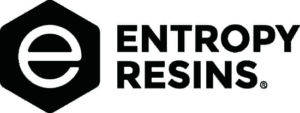Evoking Rivers & Streams with Epoxy Casting
Woodworker Noah Witenstein creates beautiful furniture and other works of resin art that play off the natural beauty of wood while keeping ecological concerns at the forefront of his designs. His company is NJW Woodworks in Long Beach, California. Noah was kind enough to share his approach to woodworking, resin casting, playing with color and light to mimic water, and how he explores the endless possibilities of his craft.
Entropy Resins: Tell people a little bit about your work.
Noah Witenstein: I work primarily with live edge wood and resin. What drives me in my work and the connection I feel with my materials is how they connect me to deeper thoughts that go well beyond the confines of my workshop. From a conceptual standpoint, my work is an active meditation in balance and looking deeply. Whether that’s the aesthetic balance of the finished work or ideas of balance surrounding the intersections of the human world and natural world—which are of such incredible importance now—I work on these ideas as I work on my art.
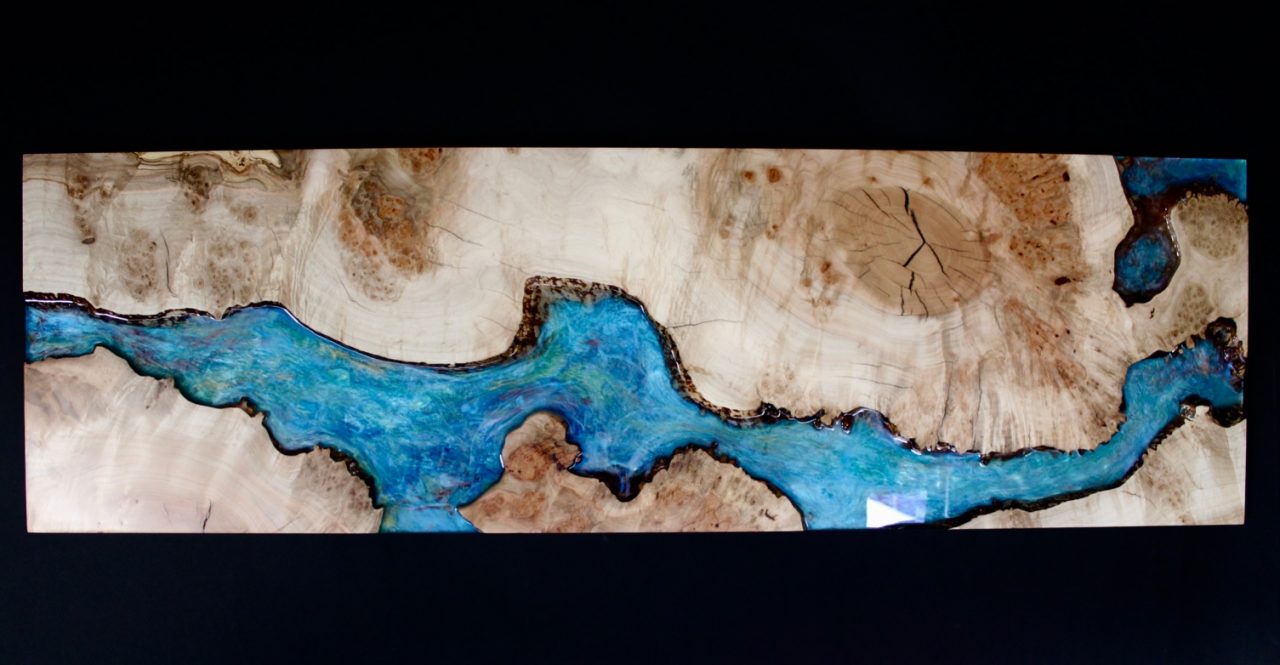

Entropy Resins: Why did you choose this medium?
Noah Witenstein: Honestly, I didn’t so much choose it as I discovered it as it was unfolding. When I started working with wood I just slowed down. I recognized it was a moving and active meditation for me. I started out making handmade wooden coasters for my wedding. As I was sanding them down I found that the more I sanded, the more of the wood’s detail came out. The more its beauty came out. The more the character in the wood grain came out. It really just hooked me. Wood as a material has just been this gateway for me. That was my entry into wood.
Then a buddy asked me to make some awards for his company. He gave me creative license—really, carte blanche—on the design. I talked him into letting me use resin in the awards, then I began making test pieces with epoxy. I started learning about casting and full pours, and it made sense to me to marry wood with resin and learn everything that I needed to about the product. I was working in a small space, so using a very low-VOC product was important to me.

Entropy Resins: How long have you been using Entropy Resins?
Noah Witenstein: I heard about Entropy around a year and a half ago. I started learning about the goals, processes, and products you’ve developed and I was impressed. When I looked at the idea of really taking responsibility for the whole lifecycle of process and development, not just the product, that mindset really resonated with me. The thing is, I look at the balance of our natural world and our manmade world. For me, the resin represents how we can—in a beautiful way and balanced way—bring these two worlds into balance. Then the epoxy, which starts as a liquid, came to symbolize water. This gives me the ability to balance the solid and the liquid. Land and sea. Opposites and parallels.
Entropy Resins: Why did you start using Entropy Resins?
Noah Witenstein: I am always on the hunt to discover and support innovative thinking that seems in line with the ideas of responsibility and stewardship. That comes from a deeper understanding of the interconnection in the world and how this ripples through all aspects of our endeavors—whether my art or Entropy Resin—from materials, processes, and intention for the end product. On top of these expectations, the final product has to be of the highest level of clarity, UV resistance, and strength.
I want to support companies that are trying to push and innovate. Companies that are thoughtful and responsible, not just in what they say they’ve done but in what they know they’ve done. And that’s what I felt was going on with Entropy Resins. The first time I purchased Entropy, I was fully on board. For me, at my scale, it was about a $700 purchase. It wasn’t like I got a little sample pack to try out. I just decided to go for it. And I’ve really been happy with it.
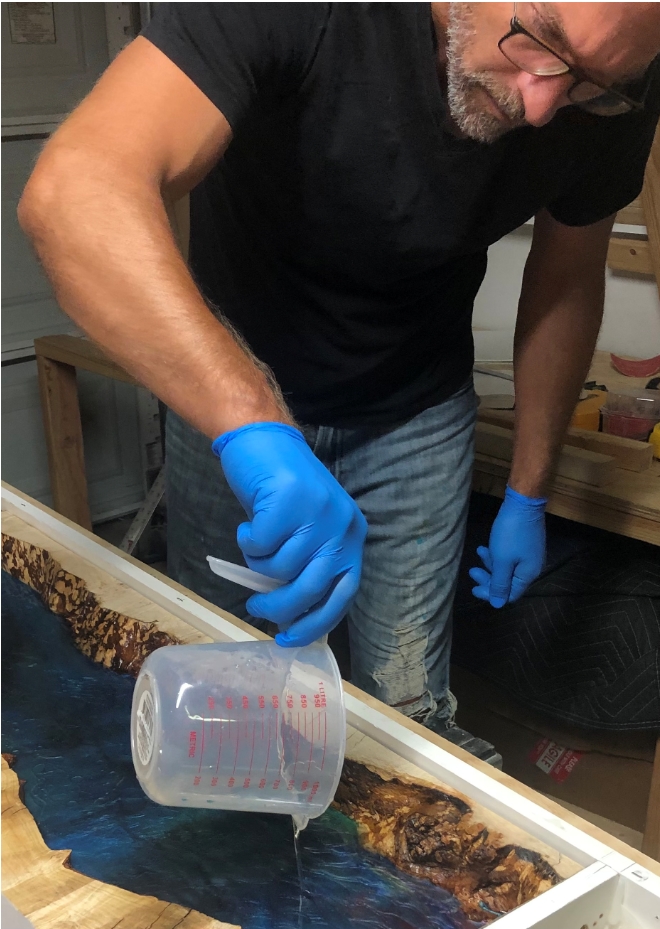
Entropy Resins: Your pieces seem to have quite a bit of depth to them with the visible swirls. Are you doing layered pours to get that depth?
Noah Witenstein: I’m trying to now work with multiple elevations of wood, even in one piece. When I create the void for the epoxy, there is usually anywhere between an inch to an inch and a half of space. I apply a sealer coat in the space, and then I work on adding layers. I most heavily color the layers that are lowest and then, typically, I build forward from the back. As I’m building up layer upon layer, I’m incorporating resin-art techniques. So I may have separate volumes of clear epoxy in a layer, and cups of resin that are tinted lightly. Then I’ll tease those together in a layer so it’s not a layer of flat color. I’ll play with it all the way up, sometimes up to 17 different layers of colorwork. Alternating the clear epoxy through the colorwork, you get a little bit of that depth that you can see. I think it communicates the idea of fluid motion. I want it to be more than just an artificial representation of water. Water has so many different moods and personalities. It’s beautiful in that sense.
The cured epoxy needs a finish of about 3000-grit (sandpaper) to get it up to clarity before polishing, Usually, I’ll sand the wood to about that grit as well. Then the wood gets this satiny texture. It’s a labor of love. And once I go over 800-grit, I don’t use anything like an orbital sander on it. It’s all hand sanding so I can get into the contours and the softness and everything like that.
Entropy Resins: Which products do you use and what is the application process you go through?
Noah Witenstein: So far, I’ve only used the CCR (Clear Casting Epoxy) in my work. I build up the resin layer by layer to create the sense of depth and movement I hope to achieve in each piece. Color control is essential for this. CCR with the CCF Fast Hardener gives me the medium I need to balance the control and letting go that’s involved in resin artwork.
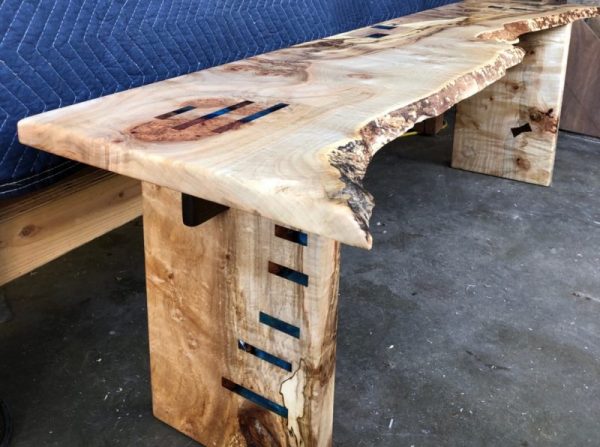
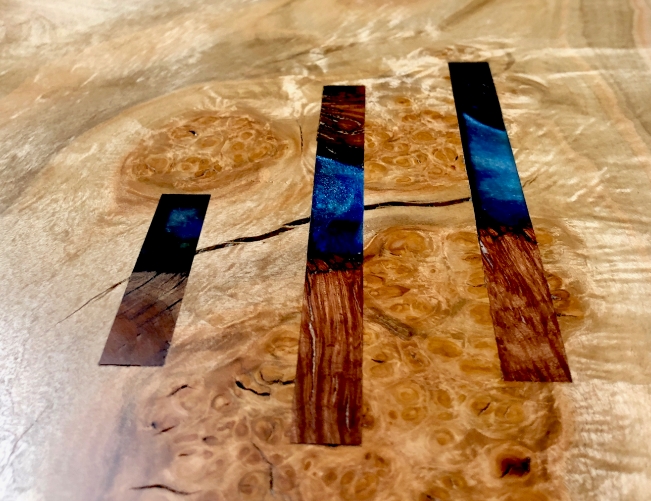
Entropy Resins: What sets our products apart from other resins you have used?
Noah Witenstein: Before I started using Entropy, I used a resin that had a pretty short pot life in comparison to Entropy CCR. While the color control was there, I would sometimes find myself racing the clock. With CCR I am able to be a bit more relaxed while doing epoxy castings. It gives me a lot more time to experiment and play during this process.
Sustainability is balance—and balance isn’t static, it’s dynamic. —Noah Witenstein
Entropy Resins: How do you incorporate sustainability into your life? Why is it important to you?
Noah Witenstein: I think this is a constant process. Sustainability is balance—and balance isn’t static, it’s dynamic. Thousands of choices and actions give us the opportunity to be intentional and thoughtful on so many levels, from our relationships with ourselves, others, and the world around us. What’s most important is shifting the mindset so that we prioritize this approach and give it value. I try to bring value to this in every aspect of my life. This planet is our home. Our home is ourselves. If we don’t care for our home we’re not caring for ourselves. I can’t think of anything that’s more important than this.
Entropy Resins: How are you sourcing wood?
I got turned onto this concept of urban wood. It’s basically wood that’s pulled from our urban environments, so, our neighborhoods. It’s not like reclaimed lumber. It’s not reclaimed old barn wood from a barn that’s being torn down. It’s actually like when in your city parks, they’re cutting down trees and they’re hauling them away. So typically, what happens is they’re chopped or shredded or turned into firewood or they haul them off to the landfill. They become part of the waste stream. The urban wood market focuses on pulling these trees out of the waste stream cycle. They bring them to urban wood mills where they mill the wood, dry the wood, and make sure that it is sold in the wood slab market for woodworkers, architects, and designers. It prevents foresting and logging from old-growth forests. It provides a pretty big diversity of wood because people are planting all sorts of trees, whether they should or shouldn’t. It can be people’s houses and yards that these trees are coming from, or parks and other city environments.
I get urban wood from a company called Street Tree Revival, which is a subsidiary of WCA (West Coast Arborists, Inc.) I’m super happy to support them, too. I’m trying to experiment in the spirit of cutting down on process and waste. It’s a sustainability-minded approach to doing business.
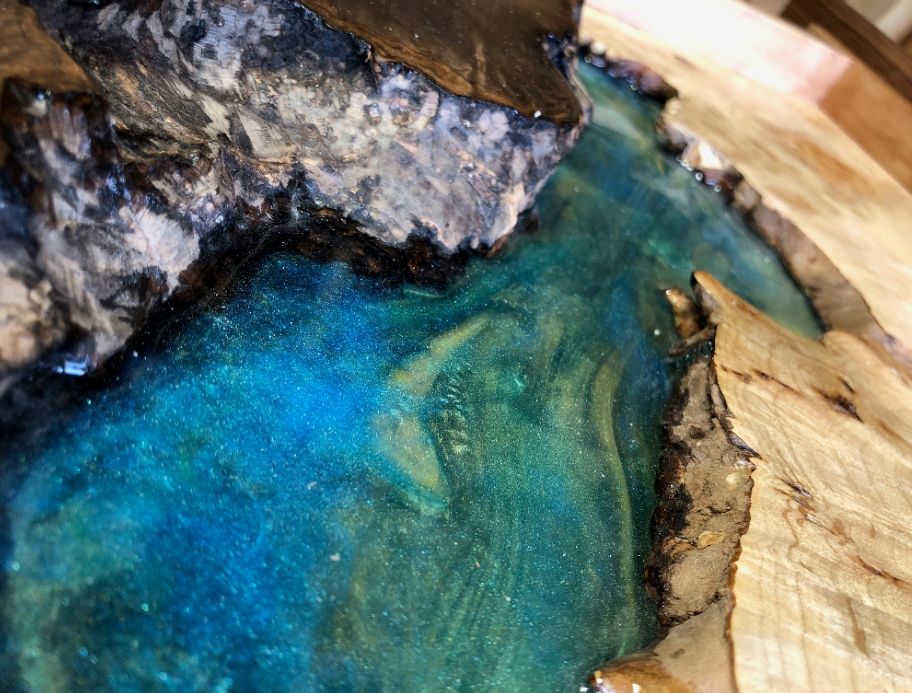
Entropy Resins: Any cool tips or tricks for resin casting to share with other makers?
Noah Witenstein: These are the top three things that come to mind from the perspective of my work:
- Light is just as much an element to consider when doing layered colorwork. How a casting might catch light from different angles, and move as light moves, can add a whole new dimension.
- Experimentation and fun are the best ways to learn your own style. With resin, once the basics are down like proper mixing and sealing, whatever the workpiece might be that the epoxy will go in.
- Don’t overwork it.
To learn more, visit njwwoodworks.com.
Photo Credits: All images, including background and featured images, are ©Noah Witenstein and feature the artist’s original works.
Special thanks to Logan Gougeon for interviewing Noah. Some quotes have been altered for clarity and brevity.
